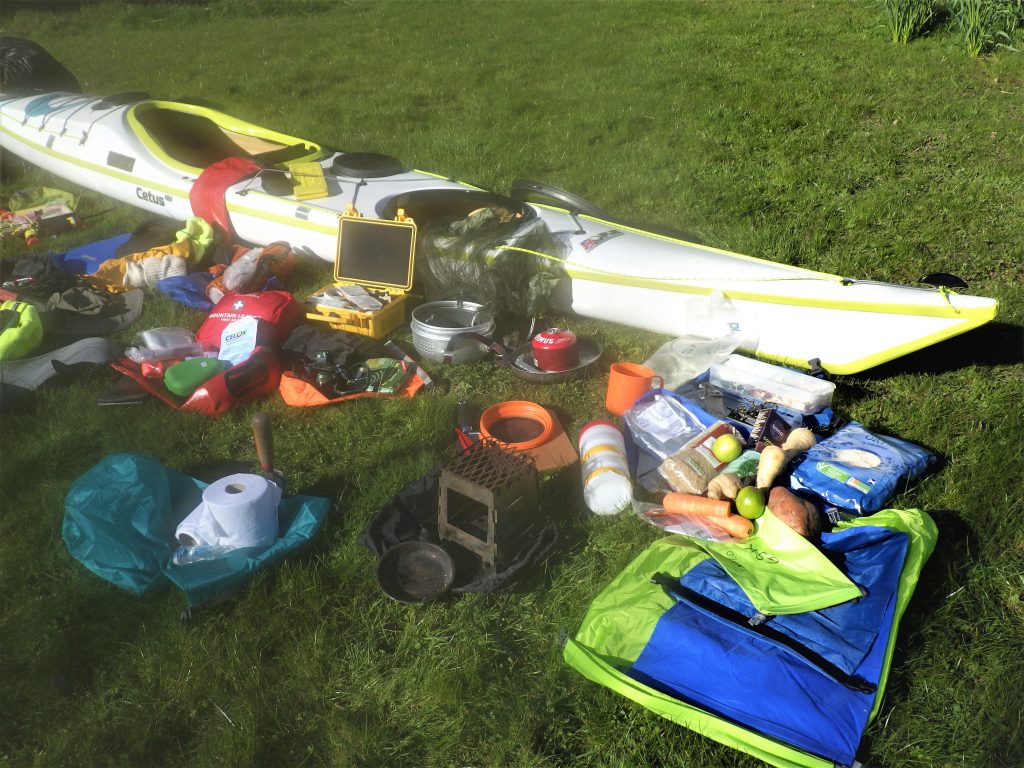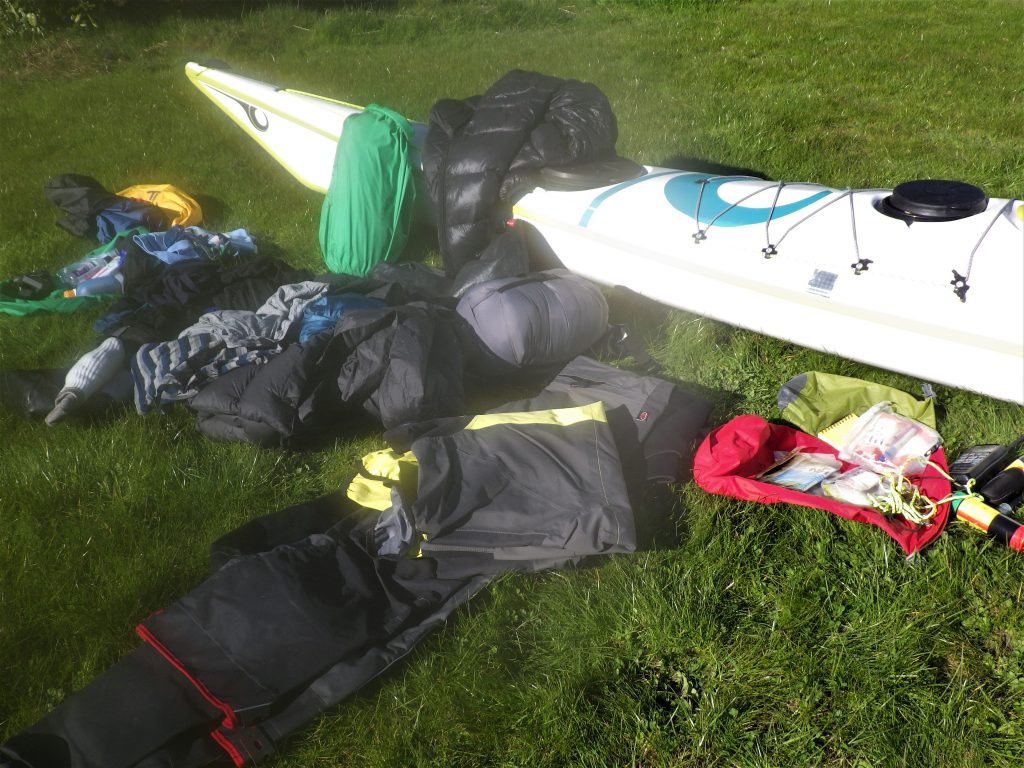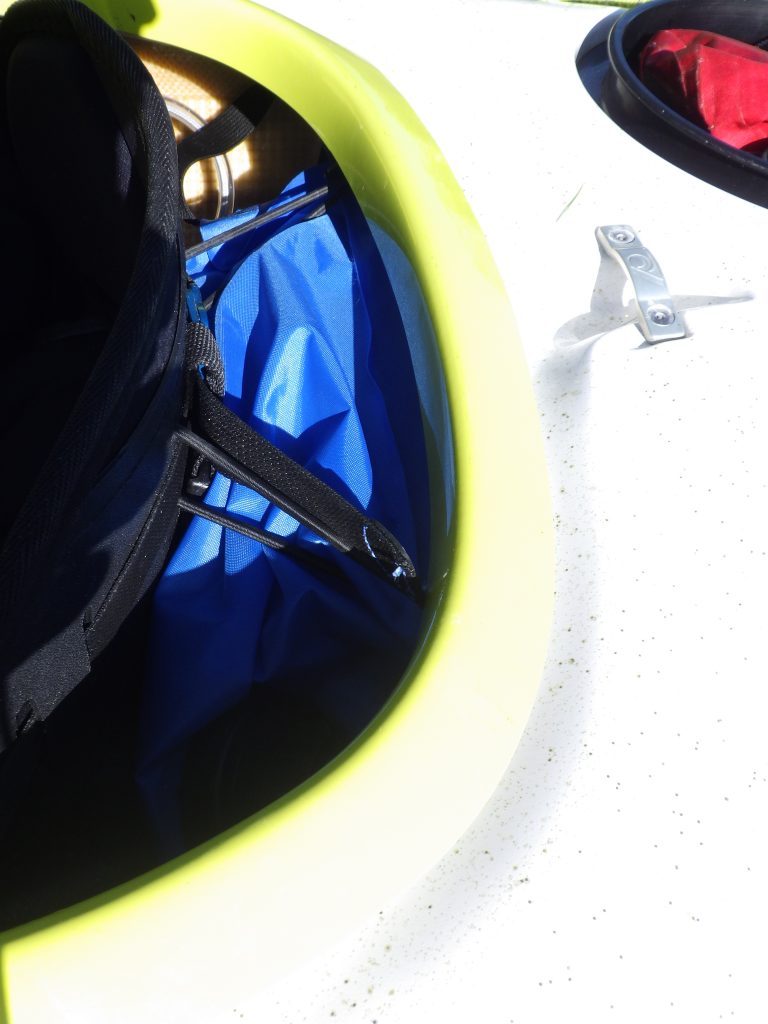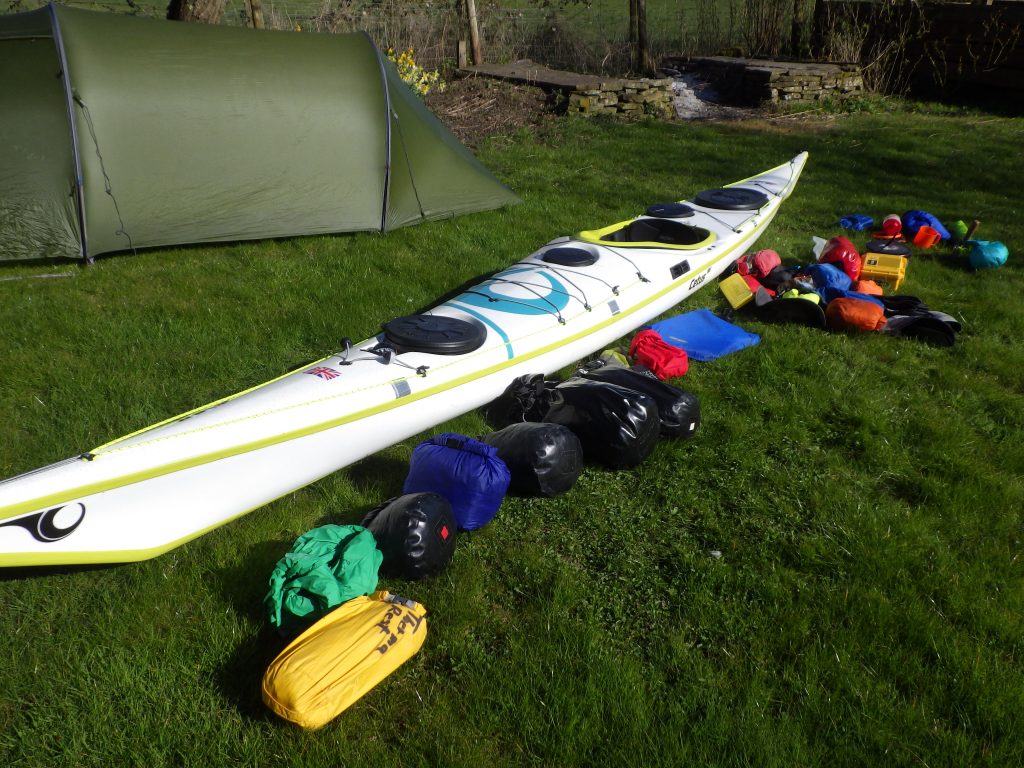Okay, you have decided to head off on a Sea Kayaking expedition but now you have the daunting prospect of getting all that kit into your kayak. Other than what is to follow the number one piece of advice I can offer is practice and practice, before you arrive at your start. No matter what system you come up with and no matter what expedition kit you decide to take from the luxury 12 tog duvet to a minimal tarp and fire stick, make sure it all fits in your sea kayak before you leave home and drive up the motorway, that is the #1Rule.

Typical kit for a nine night or weeklong trip can end up looking something like this. Of course, it depends on personal preference and how sociable you intend to be with other paddlers but in general this is the sort of volume you can expect to carry.
First of all, you need to develop a packing system that suites you and can be replicated when afloat. For my self I keep the day hatch for all my usual handy items that might be required whilst paddling.

This includes, spare towline, Tuilik, poggies, woolly hats & gloves, sun hat, sun glasses, sit mat, Blizzard Jacket, Reed hatch covers and Phone.
In the front hatch I keep all my personal items for use when the days paddling is done.

Here we find the tent, sleeping mat, sleeping bag (see previous blog on sleeping bag options) wash kit and torches, down jacket (also used as pillow), personal clothing except for camp trousers are all merino wool including: T-shirts, long sleeved jerseys, long johns, boxer shorts and camp socks plus tent socks. A key point for Expedition camp craft is to have a completely separate set of clothes for inside the tent and keep these dry at all costs. In addition to all this I carry a spare set of Nookie salopettes and dry cag, part of the just in case kit.

The rear hatch is the working hatch for me, in that it carries all the bulk items that either get used once camp has been set up or if needed during the day.
In no particular order we have: expedition first aid kit, expedition repair kit, mosquito nets and repellent, Trangia 2 pans with gas adapter & canister, real fire lighting kit and foldable stove again part of the just in case kit, 2 Litres of water, as much fresh food as possible + tins, cooking utensils, chopping board and then the vital; metal trowel, loo roll, hand sanitiser and turbo lighter, no imagination needed. In addition, there are also a selection of unused dry bags rolled up and stored right back in the stern, just in case.

With the P&H Cetus and many expedition sea kayaks you have the luxury of the 4th hatch and this is where apart from chocolate, I keep at hand my communication kit. In a grab bag I have the PLB, 2 x Day and Night flares, Laser Signal Pen and then some on the water repair kit, denso patch, wax, sticky putty, seal repair tape, dyneema short tow. In a separate dry bag waterproof paper, crayon, pencil, permanent pen, tide information and calculations. Finally, the all-important VHF with GPS and DSC signalling.
One other vital bit of kit worth carrying if you are not sure of where or how the water supply will be running when you get there is a large collapsible water bag. In addition to the 2 litres in the rear hatch think about a 5 or 10 litre bag behind your seat?

Once you have decided on all the equipment you wish to carry on your expedition, stop think a bit longer and then take out anything that will not be used, unless it is emergency kit. Following an expedition reflect on what worked well and what was not quiet as you expected and adjust your kit list while the experience is still fresh than next time you will be more proficient, remember we are always learning.
Now the key with packing is to get all this kit into the funny shaped recesses of your sea kayak. The best way to do this is to pack everything into many different dry bags, more is better in this instance. Utilising the smallest dry bag you can for the various individual items. This way you will have no problem getting the equipment through your hatches and lots of options for positioning within the hatch. Long thin items do well in the extreme ends of the kayak and if you have difficulty retrieving these a tent pole with a tent peg taped on can be used. In the rear hatch gas cannister and Sweet potatoes and other root vegetables do very well pushed up past the skeg

Multiple dry bags of various sizes and colours are best used and a handy hint is to mark you bags to help remind you of what is where.
In this photo for the front hatch from the left we have: yellow Dry Bag (DB) sleeping mat, Green DB wash kit, Black DB with red tape down jacket, Blue DB personal clothes, Medium black DB down sleeping blanket, Large black DB sleeping bag, Narrow black DB with white tape spare salopettes and dry cag. This front hatch will also carry the tent in a long thin green DB marked Tent.
Create whatever works for you, colour coding, size variants, labelling or as here a combination of both, remember practice and practice will pay off and you will be rewarded when on that remote windy beach.
Take a look at this clip showing all the kit featured above being loaded into the sea kayak. The real time packing and taking down of the tent comes in at under 10 minutes. On expedition it is always best to leave one tent up until the end unless the weather is exceptional. This will be for any unforeseen emergency that could arise or if it is blowing and you wish to have that final hot drink or briefing before getting afloat then you have an option.
One final thought regarding food, is to take eggs within the Trangia for the start of the expedition and if your island hoping is fortunate enough to travel past a community shop see if they have frozen milk and other frozen provisions. Not only are you supporting their economy these will last for a few days packed below the water line in the stern. For those that are more organised and want to plan ahead some of the local community stores on the west coast of Scotland will happily take an order in advance and you can collect when you arrive, this saves taking all the provisions in one go.
Whatever you choose to do and however you decide to pack your sea kayak have fun exploring and I look forward to seeing you afloat on the big blue.


